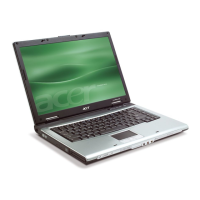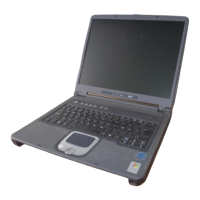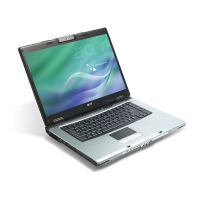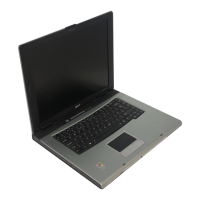
Do you have a question about the Acer TravelMate 2420 and is the answer not in the manual?
| Storage | 40GB HDD |
|---|---|
| Optical Drive | DVD/CD-RW Combo Drive |
| Wireless | 802.11b/g |
| Processor | Intel Celeron M |
| Chipset | Intel 910GML Express |
| Display | 14.1 inch TFT LCD |
| Resolution | 1024 x 768 |
| Graphics | Intel GMA 900 |
| Operating System | Windows XP Professional |
| Battery | 6-cell Li-ion battery pack |
| LAN | 10/100 Mbps Ethernet |
| Modem | 56K ITU V.92 |
| Ports | 3 x USB 2.0, VGA |
| Weight | 2.8 kg |
| RAM | 256MB DDR2 SDRAM |
Instructions for disposing of electronic products with LCD/CRT screens, focusing on mercury content and recycling.
Overview of available user guides, including beginner's poster and detailed system manuals.
General advice on using and maintaining the computer, covering power and basic care.
Guidelines for protecting the computer from environmental factors and physical damage.
Recommendations for maintaining and handling the AC adapter and its cables.
Advice on battery care, replacement, and disposal according to regulations.
Steps for cleaning the computer safely and when to seek professional help.
Warnings about unauthorized modifications and FCC operational conditions.
Protects data with passwords and advanced encryption algorithms.
Secures removable data, optical drives, and floppy drives by locking them.
Optimizes system performance by managing memory, disk, and speed settings.
Creates system backups and restores data, offering flexible and complete recovery.
Accesses system information and adjusts hardware and system settings easily.
Manages battery power by adjusting CPU speed, display brightness, and other functions.
Selects projector resolutions for presentations, such as XGA and SVGA.
Identifies and describes the components visible on the front of the laptop.
Provides a detailed view of front-facing ports and indicators with their functions.
Details the ports and features located on the left side of the laptop.
Describes the ports and features found on the right side of the laptop.
Identifies the connections and indicators on the back of the laptop.
Explains the components and features located on the bottom of the laptop.
Explains how to use the touchpad, including basic gestures and button functions.
Describes the function of Caps Lock, Num Lock, and Scroll Lock keys.
Explains the special functions of the Windows key and application key.
Details the function of key combinations for quick access to system features.
Explains how to use special character keys like the Euro and Dollar symbols.
Instructions on how to adjust the audio volume using keyboard shortcuts.
Explains how to configure and use the Acer GridVista utility for multi-monitor setups.
Describes how to configure the quick launch buttons on the keyboard.
Guides the user through performing a system scan to detect and remove viruses.
Troubleshooting steps for when the computer does not start or power on.
Solutions for issues like a blank screen or incorrect display resolution.
Troubleshooting steps for when the computer does not produce sound.
Method to eject the optical drive tray without powering on the laptop.
Advice for diagnosing and resolving issues with the laptop's keyboard.
Steps to troubleshoot printer connectivity and functionality issues.
Instructions for setting up the modem's location for communication software.
How to restore the system to factory settings using the built-in recovery feature.
Information about the International Travelers Warranty and its benefits.
Essential information to have ready when contacting Acer technical support.
Steps to safely disconnect the laptop from external peripherals before moving it.
Advice for moving the laptop within a building, like between rooms.
How to prepare the laptop for moving, including sleep mode and power off procedures.
What to pack when attending short or long meetings, considering battery life.
Advice on protecting the laptop from temperature changes and condensation during travel.
Guidelines for traveling between countries, including power adapter and customs considerations.
How to use a Kensington lock to physically secure the laptop.
Explains the importance of passwords for system and data protection.
Steps for entering and setting up passwords for BIOS, user, and boot-up authentication.
Describes how laptop ports can connect to peripherals like a desktop computer.
Details the built-in fax/data modem and its compatibility.
How to connect the laptop to an Ethernet network using the integrated port.
Explains the function and use of USB 2.0 ports for connecting peripherals.
Information about PC Card slots for expansion and the procedure for removing a card.
Guides for installing RAM and accessing the BIOS utility for system configuration.
How to configure the boot sequence using the BIOS utility.
Enables the hard drive recovery feature through the BIOS settings.
Procedure for setting initialization passwords via the BIOS utility.
How to play DVD movies, including regional code information.
How the system manages power to conserve battery life and optimize performance.
Steps to create a system backup image to HDD or optical media.
How to restore the system from a previously created backup.
Instructions to create recovery CDs if system CDs are unavailable.
How to reinstall preloaded software and drivers without physical media.
Procedure to change the password for Acer eRecovery Management and disk-to-disk recovery.
General advice and how to use error messages for troubleshooting.
Table listing common error messages and their corrective actions.
Statement regarding the product's compliance with ENERGY STAR efficiency guidelines.
FCC compliance statement regarding radio frequency interference and operational conditions.
Requirements for using shielded cables and certified peripherals for FCC compliance.
Warnings about modifications and further details on FCC compliance conditions.
EU compliance, modem approval, and country-specific compatibility information.
Laser product safety declaration for CD/DVD drives.
Information regarding potential pixel defects on the LCD unit.
Notice regarding copyright protection technology used in the product.
General standards for wireless devices and specific regulations for Canada (RSS-210).
EU directives compliance and FCC radio frequency exposure limits.
Canadian RF field exposure guidelines and regulations for radio devices.











